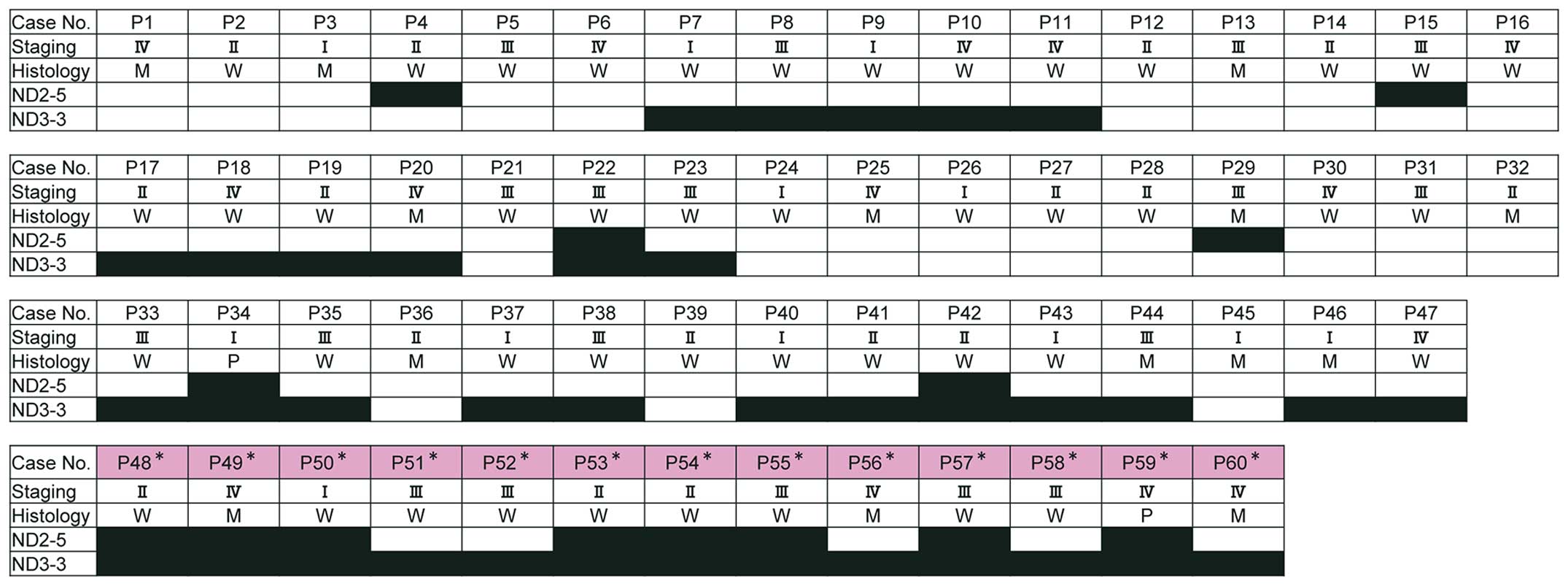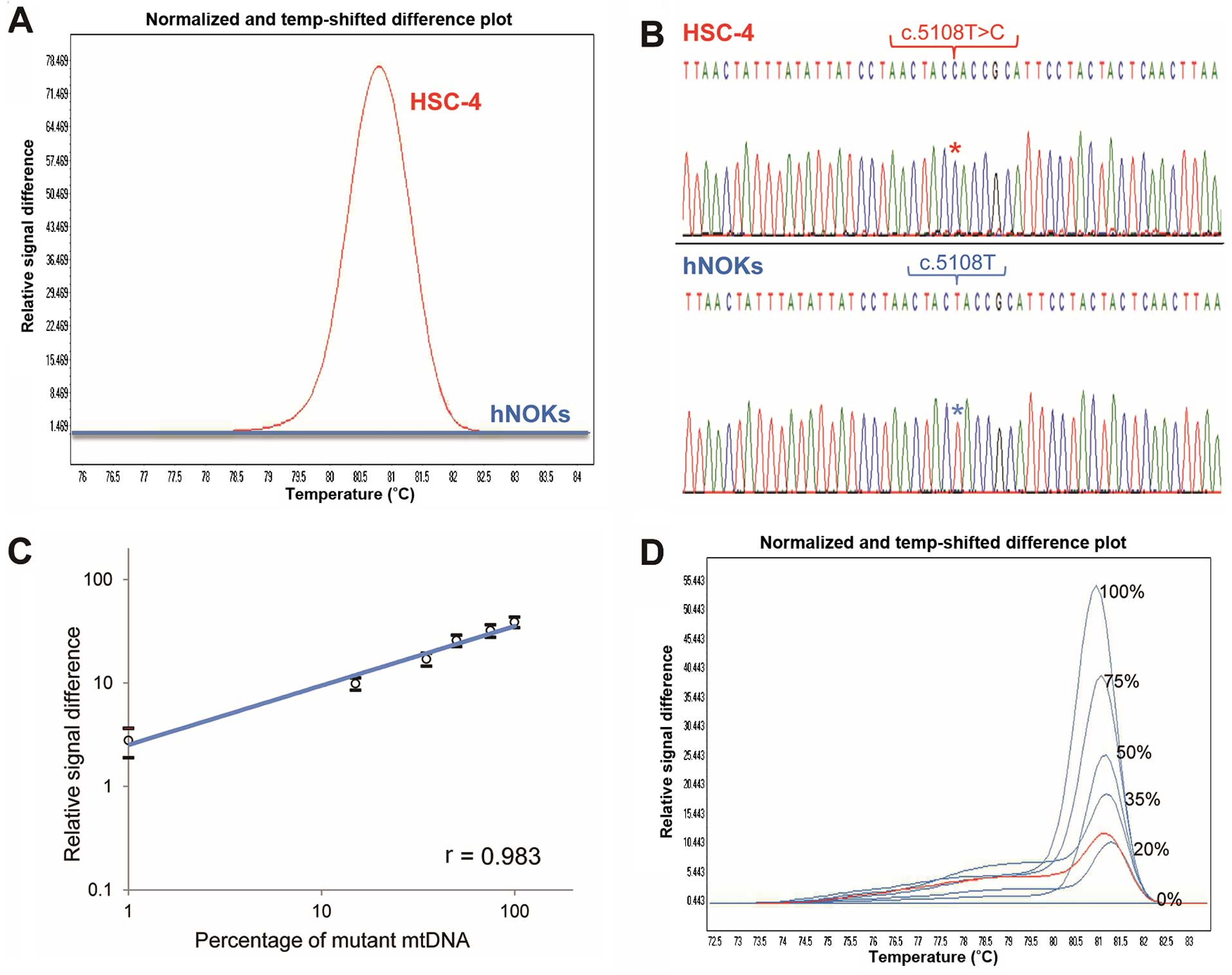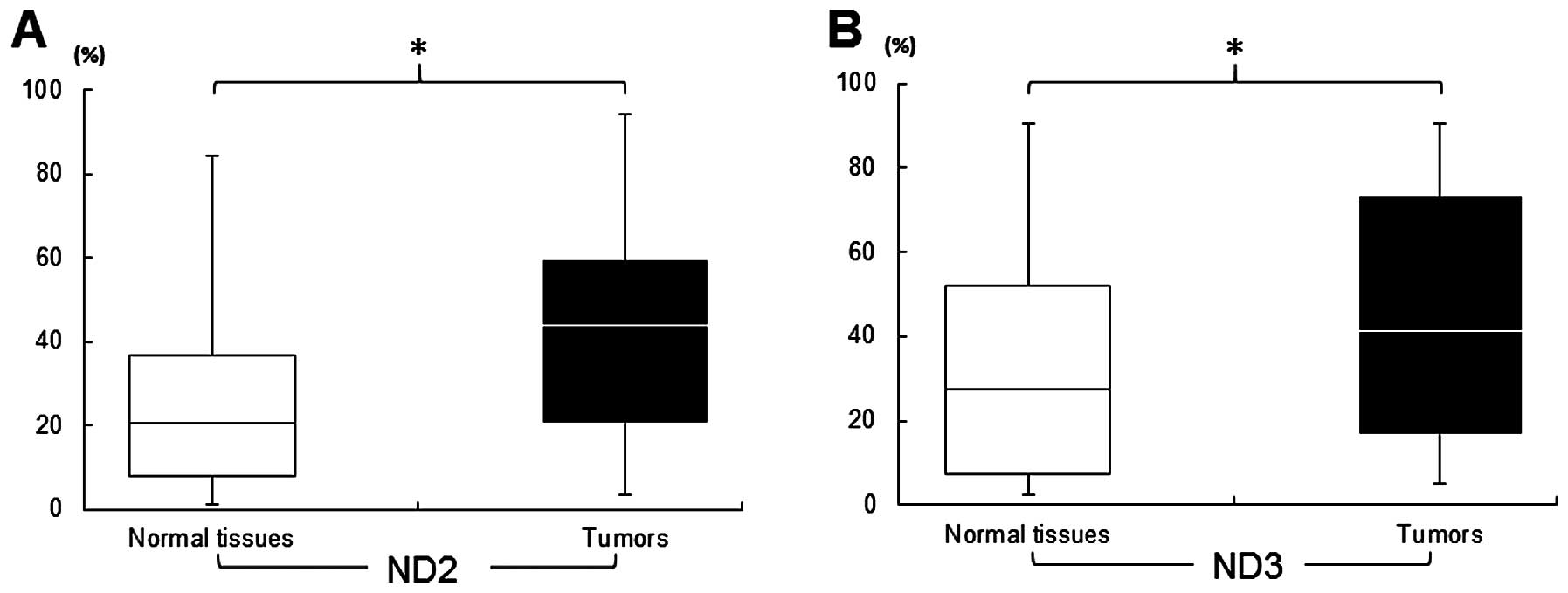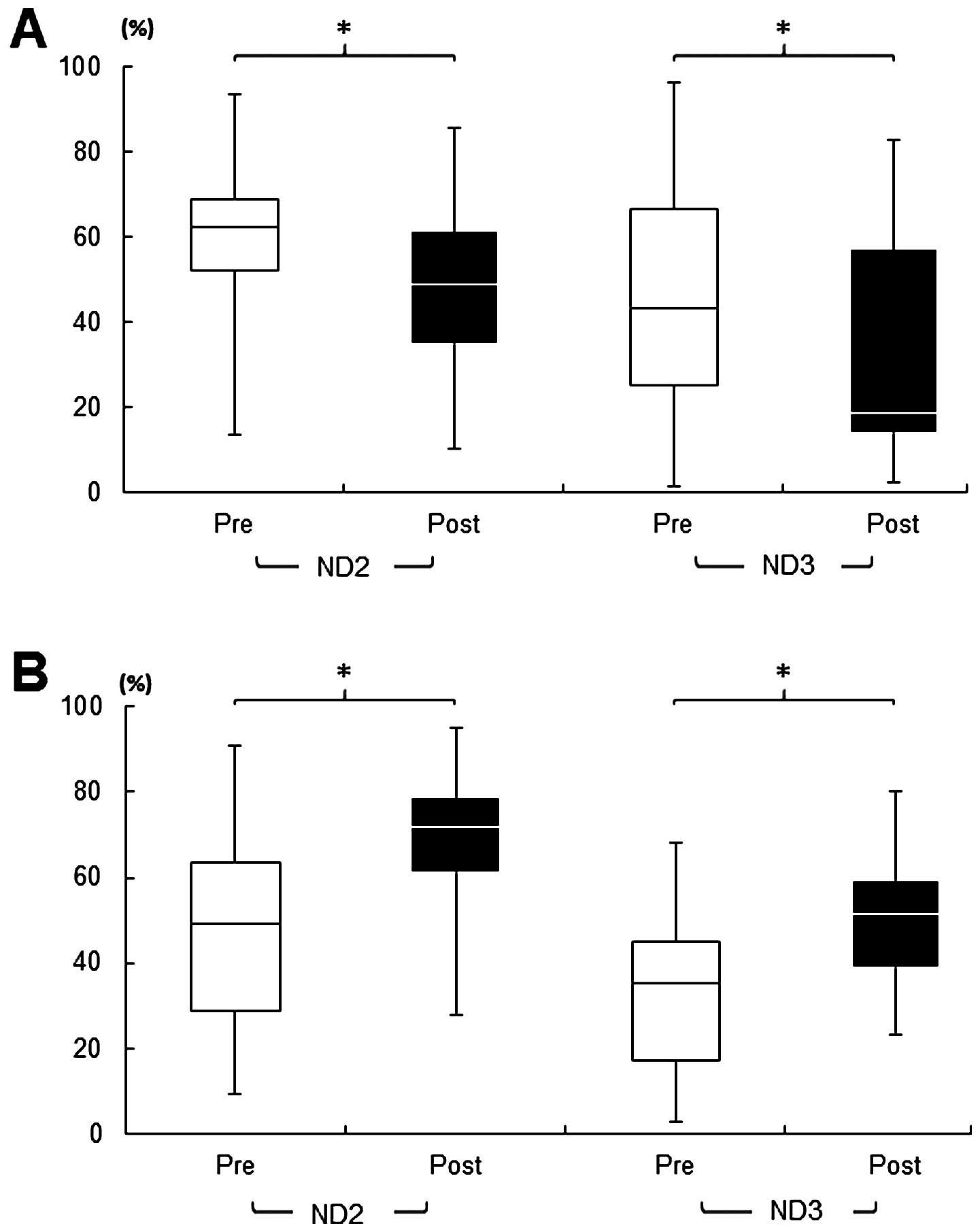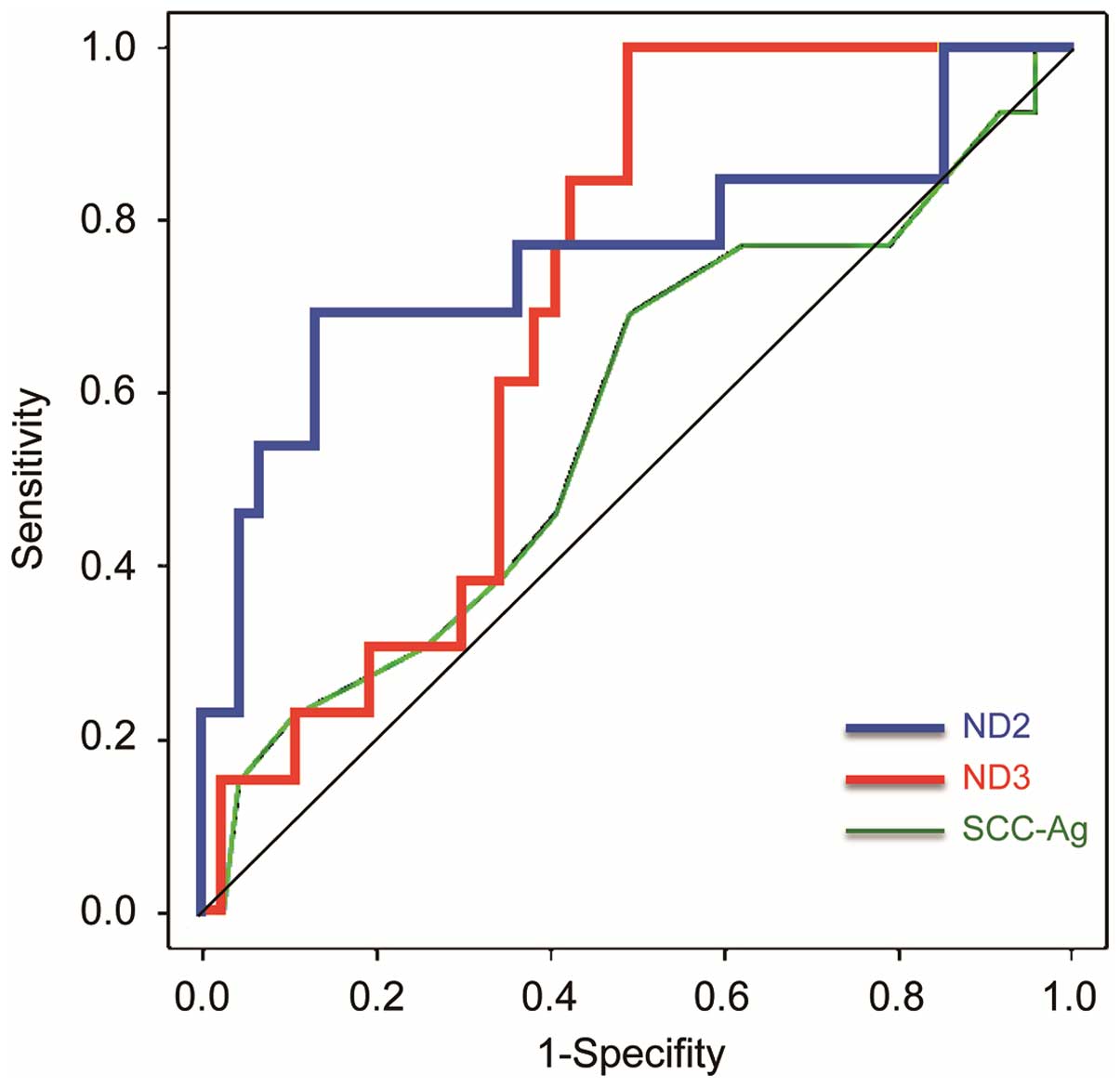Quantitative detection of circulating tumor-derived mitochondrial NADH subunit variants as a potential prognostic biomarker for oral cancer
- Authors:
- Published online on: July 15, 2015 https://doi.org/10.3892/ijo.2015.3083
- Pages: 1077-1083
Abstract
Introduction
Since conventional approaches cannot detect micrometastasis with high sensitivity, development of novel and effective methods is needed. Circulating tumor cells (CTCs) and/or their specific molecules are important determinants for predicting poor prognosis in patients with cancer (1–4). CTCs also are measured to assess the therapeutic effects of chemotherapy, radiotherapy and chemoradiotherapy (5–8). CTCs or tumor-associated DNAs also have been detected frequently in serum samples from poorly diagnosed patients with oral squamous cell carcinoma (OSCC) (9,10), indicating that this type of blood test is useful during cancer treatment and follow-up to monitor patients for recurrent or metastatic lesions.
Due to low cellular copy numbers of genomic DNAs in serum samples, isolating sufficient DNA for molecular analyses can be difficult. Considering this, we recently reported the clinical relevance of detecting tumor-derived mutant mitochondrial DNAs (mut-mtDNAs) at the regions including the D-loop, 12S-rRNA and 16S-rRNA, the copy numbers of which are much higher than those of genomic DNAs (11). To examine whether discrete mutation(s) may exist in the mitochondorial genome, and moreover, detection of CTCs with the mutant mitochondrial DNA could be useful to predict micrometastasis of patients with OSCC with no histologic evidence of cancer cells in their surgical margins, we used a comprehensive approach for detecting tumor-derived mut-mtDNAs in the ND2 and ND3 regions by quantitative real-time polymerase chain reaction combined with high-resolution melting curve analysis (qRT-PCR-HRMA). This investigation showed compelling evidence that evaluation of circulating tumor-derived mitochondrial DNAs with ND2 and/or ND3 mutation may be an additional clinical tool to monitor the post-operative patients with OSCC.
Materials and methods
Ethical statement
The study protocol was approved by the Ethics Committee of the Graduate School of Medicine, Chiba University (approval number, 236) and was performed in accordance with the ethical standards laid down in the Declaration of Helsinki. Written informed consent was received from all patients or their families.
All experimental animals were treated and cared for in accordance with the guidelines of Chiba University. Experimental animals were sacrificed by cervical dislocation. We made every effort to relieve the pain of experimental animals. The protocol was approved by the Committee on the Ethics of Animal Experiments of Chiba University (approval number, 25-221).
Mutation detection of mtDNA for OSCC cell lines in vitro and in vivo
The human OSCC-derived cell lines Sa3 and HSC-4 were purchased, respectively, from the RIKEN BioResource Center through the National Bioresource Project of the Ministry of Education, Culture, Sports, Science and Technology (Tsukuba, Japan) and the Human Science Research Resources Bank (Osaka, Japan). A DNA profiling procedure validated the cell lines (11). The cells were cultured in the same manner as previously reported (12).
Ten sets of specific PCR primers were prepared for amplification of regions ND2 and ND3 of the human mitochondrial genome. The primer sequences are shown in Table I. The PCR products were subcloned into a pCR8/GW/TOPO TA cloning vector (Invitrogen, Carlsbad, CA, USA), and then sequenced using ABI 3730xl DNA sequencers (Applied Biosystems, Foster City, CA, USA) to validate the identity of the amplified products by comparing them with the MITOMAP database (www.mitomap.org/MITOMAP/HumanMitoSeq).
We optimized the conditions and examined the feasibility of using qRT-PCR-HRMA for detecting three discrete sequence variations (ND2-T5108C, ND3-A10397G and ND3-C10400T) in Sa3 and HSC-4 cell lines. Using specific PCR primer sets (Table I), qPCR-HRMA was performed using a LightCycler 480 system (Roche Diagnostics GmbH, Mannheim, Germany) in a final volume of 20 μl of a reaction mixture comprised of 10 μl of LightCycler 480 High Resolution Melting Master Mix (Roche), 3 mM of MgCl2, and 4 μM of the primers, according to the manufacturer's instructions.
The in vivo experiments, i.e., detecting Sa3-derived mut-mtDNAs of the ND2 and ND3 regions in serum samples from BALB/cAnNCrj-nu/nu mice (n=2, Charles River Laboratories, Yokohama, Japan), were performed according to our previous methods (11). In brief, to validate whether mut-mtDNA of the ND2 and/or ND3 regions in human oral cancer cells were detectable quantitatively from peripheral blood samples, we transplanted Sa3 cells (2×106) by subcutaneous injection into BALB/cAnNCrj-nu/nu mice (n=2, Charles River Laboratories). The mice were sacrificed after 6 weeks as previously described (11). The non-Sa3 transplanted mice (n=2) were used as controls and their serum samples were collected. MtDNA was extracted from them for qRT-PCR-HRMA. All mice were maintained under specific pathogen-free conditions. Environmental conditions were a temperature of 24 ±2°C, humidity of 50±10%, lighting of 300 lux and a 12:12 light:dark cycle with lights on at 07:00 and off at 19:00. The mice were housed individually in 210×300×225 mm cages.
The committee of the Chiba University Laboratory Animal Center reviewed and approved the protocol.
Determination of mut-mtDNAs in patients with OSCC
Sixty patients with newly diagnosed OSCC with surgical malignancy-free margins were included. The patients were divided into two groups: 47 patients with a good prognosis with no recurrence and/or metastasis and 13 patients with a poor prognosis with a recurrence or metastasis 17 months post-operatively. Additional patient information is shown in Fig. 1.
Overall, we analyzed 240 mtDNAs comprised of normal tissue, tumoral tissue, pre-operative serum samples, and serum samples obtained 4 weeks post-operatively from each patient. To quantify the mut-mtDNAs in each sample, the qRT-PCR-HRMA procedure was performed as previously described (11) with specific primer sets for the ND2 region and the ND3 region (Table I). The amount of each mut-mtDNA in the samples was determined based on the standard curves that were created by diluting mut-mtDNA from Sa3 or HSC-4 with wild-type mtDNAs to prepare 100, 75, 50, 35, 20 and 0% mutated samples for detecting the ND2 or ND3 region in the mtDNA genome as previously described (11).
All results, expressed as the mean ± standard error of the mean, were similar among experiments repeated three times. P-values were analyzed using the Mann-Whitney U-test. P<0.05 was considered significant. Statistical analyses were performed using Microsoft Office Excel 2010 (Microsoft, Seattle, WA, USA). For receiver operating characteristic (ROC) curve analysis, EZR software (Saitama Medical Center, Jichi Medical University, Saitama, Japan) (13) was used. We also utilized the area under the ROC curve (AUC) values with estimated odds ratios and 95% confidence intervals (CIs) to evaluate the diagnostic relevance for predicting the serum mut-mtDNAs in patients with a poor prognosis.
Results
Three homoplasmic nucleotide substitutions defined as single-nucleotide polymorphisms (SNPs) were identified in the ND2 region (T:A to C:G at position 5108) in HSC-4 cells and the ND3 region (A:T to G:C at position 10397 and C:G to T:A at position 10400) in Sa3 cells; no mutation was observed in normal control human normal oral keratinocytes (hNOKs) (Fig. 2A and B). In blood samples from Sa3-xenografted mice, we detected mut-mtDNAs identical to Sa3-associated mut-mtDNAs, but control mice did not have mut-mtDNAs (Table II). The results indicated that this blood test is clinically useful for detecting tumor-related mut-mtDNAs. Based on the melting curves separated by the HRMA chromatogram, we created a standard curve by serial dilution of the DNA from hNOKs (Fig. 2C and D) and detected the mut-mtDNA amounts in samples from the mice and humans examined. Typical results are shown in Fig. 2D.
As previously described (11,14), we isolated sufficient mtDNAs for analysis from clinical samples (n=240) from 60 patients with OSCC (746.8±476 ng/μl, tissue samples; 761.7±340 ng/μl, blood samples). In resected tissues, a significantly (P<0.05) higher concentration of mut-mtDNA was detected in tumoral tissues from patients with a good prognosis and a poor prognosis, compared to each normal counterpart (Fig. 3). The blood test analyzed by qRT-PCR-HRMA indicated that surgery significantly (P<0.05) decreased the circulating mut-mtDNAs in patients with OSCC without recurrence and/or metastasis (Fig. 4A). Compared to the group with a good prognosis, a significant (P<0.05) increase in the circulating tumor-associated mut-mtDNAs was confirmed in the blood samples obtained postoperatively from patients with a poor prognosis (Fig. 4B), all of whom had substantial mut-mtDNA in their serum, without exception, in at least one region examined (Fig. 1).
The area under the ROC curve (AUC) values were more sensitive across a range of mut-mtDNA levels in the sera for the risk of recurrence/metastasis than serum SCC antigen (SCC-Ag) levels (Fig. 5). Using the optimal threshold values of 68% (sensitivity, 61.5%; specificity, 87.2%) for ND2, 22.9% (sensitivity, 92.3%; specificity, 51.1%) for ND3, and 1.0 ng/ml (sensitivity, 69.2%; specificity, 51.1%) for SCC-Ag, each AUC was 0.761 [95% confidence interval (CI), 0.580–0.9421, P<0.05], 0.704 (95% CI, 0.5696–0.838, P<0.05) and 0.574 (95% CI, 0.386–0.761, P=0.793), respectively.
Discussion
CTCs are promising clinical tools in many human cancers (15–17). Evidence indicates that the epithelial cell adhesion molecule is one of the most useful molecular markers for detecting CTCs, including human SCCs (18,19). In contrast, Wirtschafter et al (20) reported that CTCs were validated only in a small portion of patients with head and neck SCC, suggesting limited clinical application.
The present study, in which a unique set of human OSCC specimens was used, found that circulating mut-mtDNAs at the ND2 and/or ND3 regions are significant predictive biomarkers for postoperative recurrence/metastasis in OSCC. Nawroz et al (21) first reported their potential clinical use by detecting tumor-derived microsatellite alterations in serum genomic DNAs in patients with head and neck cancer. Recently, accumulating data on circulating mtDNAs have been published on malignant tumors (22–24) and other human diseases (25–28). From a clinical standpoint, there are several benefits to adopting mtDNA for clinical blood tests: DNA, including genomic DNA and mtDNA, is more stable than RNA, including mRNA and microRNA, and extracted protein; as He et al (14) and we (29) reported, the copy number of the mtDNA is hundreds to thousands of times higher than that of genomic DNA; and a high rate of somatic sequence variations resulting in a pathogenic state are present in patients with OSCC.
We identified cancer-specific somatic variants in the ND2 and ND3 regions (Fig. 1B). These genes encoding ND2 and ND3 are subunits of NADH, which may act as the rate-limiting enzyme of oxidative phosphorylation (30). Alterations in these genes are correlated with human cancers (31–33). It has been proposed that once these genes function abnormally in cancer cells, enhanced reactive oxygen species induces HIF1α stabilization (34,35). Thus, we speculated that genetic mutations identified in the present study, even in SNPs, may be linked partly to the above-mentioned mechanisms for oral tumorigenesis. In this context, several studies have reported an association between SNPs on mtDNA, especially in the ND3 region, and the risk of developing breast cancer (36–38).
We previously described the usefulness of qRT-PCR-HRMA for searching mtDNA mutations with high sensitivity/specificity. As indicated in the present study, our method, even in different regions on the mitochondrial genome, is sufficient for clinical use as well. However, as Kandel (39) pointed out, several issues need attention such as minimization of cellular contamination, determination of mut-mtDNA characteristics specific for OSCC, and elimination of the effect of other diseases.
The study limitations were the small number of OSCC cases and the absence of other human malignancies. However, our data were highly significant for early detection of high-risk individuals with OSCCs, since subjects expected to have a good prognosis who had recurrence/metastasis postoperatively can be distinguished by the level of tumor-derived mtDNA in their serum 4 weeks postoperatively. When a more precise approach for mut-mtDNA detection of CTCs in cancer patients is established, we will identify earlier the patients with undetectable lesions.
Acknowledgements
We thank L.C. Charters for editing the manuscript. The present study was supported by a Grant-in-Aid for Exploratory Research from The Ministry of Education, Culture, Sports, Science and Technology (MEXT) (no. 50236775).
Abbreviations:
|
CTCs |
circulating tumor cells |
|
mut-mtDNA |
mutant mitochondorial DNAs |
|
OSCC |
oral squamous cell carcinoma |
|
qRT-PCR-HRMA |
quantitative real-time polymerase chain reaction combined with high-resolution melting curve analysis |
|
hNOKs |
human normal oral keratinocytes |
|
ROC |
receiver operating characteristic |
|
CI |
confidence interval |
|
SNP |
single-nucleotide polymorphism |
References
|
Königsberg R, Gneist M, Jahn-Kuch D, Pfeiler G, Hager G, Hudec M, Dittrich C and Zeillinger R: Circulating tumor cells in metastatic colorectal cancer: Efficacy and feasibility of different enrichment methods. Cancer Lett. 293:117–123. 2010. View Article : Google Scholar : PubMed/NCBI | |
|
Mavroudis D: Circulating cancer cells. Ann Oncol. 21(Suppl 7): vii95–v100. 2010. View Article : Google Scholar : PubMed/NCBI | |
|
Khan MS, Kirkwood A, Tsigani T, Garcia-Hernandez J, Hartley JA, Caplin ME and Meyer T: Circulating tumor cells as prognostic markers in neuroendocrine tumors. J Clin Oncol. 31:365–372. 2013. View Article : Google Scholar | |
|
Bidard FC, Peeters DJ, Fehm T, Nolé F, Gisbert-Criado R, Mavroudis D, Grisanti S, Generali D, Garcia-Saenz JA, Stebbing J, et al: Clinical validity of circulating tumour cells in patients with metastatic breast cancer: A pooled analysis of individual patient data. Lancet Oncol. 15:406–414. 2014. View Article : Google Scholar : PubMed/NCBI | |
|
Buglione M1, Grisanti S, Almici C, Mangoni M, Polli C, Consoli F, Verardi R, Costa L, Paiar F, Pasinetti N, et al: Circulating tumour cells in locally advanced head and neck cancer: preliminary report about their possible role in predicting response to non-surgical treatment and survival. Eur J Cancer. 48:3019–3026. 2012. View Article : Google Scholar : PubMed/NCBI | |
|
Lu CY, Tsai HL, Uen YH, Hu HM, Chen CW, Cheng TL, Lin SR and Wang JY: Circulating tumor cells as a surrogate marker for determining clinical outcome to mFOLFOX chemotherapy in patients with stage III colon cancer. Br J Cancer. 108:791–797. 2013. View Article : Google Scholar : PubMed/NCBI | |
|
Pavese JM and Bergan RC: Circulating tumor cells exhibit a biologically aggressive cancer phenotype accompanied by selective resistance to chemotherapy. Cancer Lett. 352:179–186. 2014. View Article : Google Scholar : PubMed/NCBI | |
|
Tinhofer I, Konschak R, Stromberger C, Raguse JD, Dreyer JH, Jöhrens K, Keilholz U and Budach V: Detection of circulating tumor cells for prediction of recurrence after adjuvant chemoradiation in locally advanced squamous cell carcinoma of the head and neck. Ann Oncol. 25:2042–2047. 2014. View Article : Google Scholar : PubMed/NCBI | |
|
Hamana K, Uzawa K, Ogawara K, Shiiba M, Bukawa H, Yokoe H and Tanzawa H: Monitoring of circulating tumour-associated DNA as a prognostic tool for oral squamous cell carcinoma. Br J Cancer. 92:2181–2184. 2005. View Article : Google Scholar : PubMed/NCBI | |
|
Gröbe A, Blessmann M, Hanken H, Friedrich RE, Schön G, Wikner J, Effenberger KE, Kluwe L, Heiland M, Pantel K, et al: Prognostic relevance of circulating tumor cells in blood and disseminated tumor cells in bone marrow of patients with squamous cell carcinoma of the oral cavity. Clin Cancer Res. 20:425–433. 2014. View Article : Google Scholar | |
|
Uzawa K, Baba T, Uchida F, Yamatoji M, Kasamatsu A, Sakamoto Y, Ogawara K, Shiiba M, Bukawa H and Tanzawa H: Circulating tumor-derived mutant mitochondrial DNA: A predictive biomarker of clinical prognosis in human squamous cell carcinoma. Oncotarget. 3:670–677. 2012.PubMed/NCBI | |
|
Saito K, Uzawa K, Kasamatsu A, Shinozuka K, Sakuma K, Yamatoji M, Shiiba M, Shino Y, Shirasawa H and Tanzawa H: Oncolytic activity of Sindbis virus in human oral squamous carcinoma cells. Br J Cancer. 101:684–690. 2009. View Article : Google Scholar : PubMed/NCBI | |
|
Kanda Y: Investigation of the freely available easy-to-use software ‘EZR' for medical statistics. Bone Marrow Transplant. 48:452–458. 2013. View Article : Google Scholar : | |
|
He Y, Wu J, Dressman DC, Iacobuzio-Donahue C, Markowitz SD, Velculescu VE, Diaz LA Jr, Kinzler KW, Vogelstein B and Papadopoulos N: Heteroplasmic mitochondrial DNA mutations in normal and tumour cells. Nature. 464:610–614. 2010. View Article : Google Scholar : PubMed/NCBI | |
|
Cen P, Ni X, Yang J, Graham DY and Li M: Circulating tumor cells in the diagnosis and management of pancreatic cancer. Biochim Biophys Acta. 1826:350–356. 2012.PubMed/NCBI | |
|
Lianidou ES, Mavroudis D and Georgoulias V: Clinical challenges in the molecular characterization of circulating tumour cells in breast cancer. Br J Cancer. 108:2426–2432. 2013. View Article : Google Scholar : PubMed/NCBI | |
|
Romero-Laorden N, Olmos D, Fehm T, Garcia-Donas J and Diaz-Padilla I: Circulating and disseminated tumor cells in ovarian cancer: A systematic review. Gynecol Oncol. 133:632–639. 2014. View Article : Google Scholar : PubMed/NCBI | |
|
Bozec A, Ilie M, Dassonville O, Long E, Poissonnet G, Santini J, Chamorey E, Ettaiche M, Chauvière D, Peyrade F, et al: Significance of circulating tumor cell detection using the CellSearch system in patients with locally advanced head and neck squamous cell carcinoma. Eur Arch Otorhinolaryngol. 270:2745–2749. 2013. View Article : Google Scholar : PubMed/NCBI | |
|
Driemel C, Kremling H, Schumacher S, Will D, Wolters J, Lindenlauf N, Mack B, Baldus SA, Hoya V, Pietsch JM, et al: Context-dependent adaption of EpCAM expression in early systemic esophageal cancer. Oncogene. 33:4904–4915. 2014. View Article : Google Scholar | |
|
Wirtschafter A, Benninger MS, Moss TJ, Umiel T, Blazoff K and Worsham MJ: Micrometastatic tumor detection in patients with head and neck cancer: A preliminary report. Arch Otolaryngol Head Neck Surg. 128:40–43. 2002. View Article : Google Scholar : PubMed/NCBI | |
|
Nawroz H, Koch W, Anker P, Stroun M and Sidransky D: Microsatellite alterations in serum DNA of head and neck cancer patients. Nat Med. 2:1035–1037. 1996. View Article : Google Scholar : PubMed/NCBI | |
|
Mehra N, Penning M, Maas J, van Daal N, Giles RH and Voest EE: Circulating mitochondrial nucleic acids have prognostic value for survival in patients with advanced prostate cancer. Clin Cancer Res. 13:421–426. 2007. View Article : Google Scholar : PubMed/NCBI | |
|
Kohler C, Radpour R, Barekati Z, Asadollahi R, Bitzer J, Wight E, Bürki N, Diesch C, Holzgreve W and Zhong XY: Levels of plasma circulating cell free nuclear and mitochondrial DNA as potential biomarkers for breast tumors. Mol Cancer. 8:1052009. View Article : Google Scholar : PubMed/NCBI | |
|
Ellinger J, Müller DC, Müller SC, Hauser S, Heukamp LC, von Ruecker A, Bastian PJ and Walgenbach-Brunagel G: Circulating mitochondrial DNA in serum: A universal diagnostic biomarker for patients with urological malignancies. Urol Oncol. 30:509–515. 2012. View Article : Google Scholar | |
|
Tsai NW, Lin TK, Chen SD, Chang WN, Wang HC, Yang TM, Lin YJ, Jan CR, Huang CR, Liou CW, et al: The value of serial plasma nuclear and mitochondrial DNA levels in patients with acute ischemic stroke. Clin Chim Acta. 412:476–479. 2011. View Article : Google Scholar | |
|
Bliksøen M, Mariero LH, Ohm IK, Haugen F, Yndestad A, Solheim S, Seljeflot I, Ranheim T, Andersen GØ, Aukrust P, et al: Increased circulating mitochondrial DNA after myocardial infarction. Int J Cardiol. 158:132–134. 2012. View Article : Google Scholar : PubMed/NCBI | |
|
Kung CT, Hsiao SY, Tsai TC, Su CM, Chang WN, Huang CR, Wang HC, Lin WC, Chang HW, Lin YJ, et al: Plasma nuclear and mitochondrial DNA levels as predictors of outcome in severe sepsis patients in the emergency room. J Transl Med. 10:1302012. View Article : Google Scholar : PubMed/NCBI | |
|
Qiu C, Hevner K, Enquobahrie DA and Williams MA: A case-control study of maternal blood mitochondrial DNA copy number and preeclampsia risk. Int J Mol Epidemiol Genet. 3:237–244. 2012.PubMed/NCBI | |
|
Lai CH, Huang SF, Liao CT, Chen IH, Wang HM and Hsieh LL: Clinical significance in oral cavity squamous cell carcinoma of pathogenic somatic mitochondrial mutations. PLoS One. 8:e655782013. View Article : Google Scholar : PubMed/NCBI | |
|
Kumazaki T, Sakano T, Yoshida T, Hamada K, Sumida H, Teranishi Y, Nishiyama M and Mitsui Y: Enhanced expression of mitochondrial genes in senescent endothelial cells and fibroblasts. Mech Ageing Dev. 101:91–99. 1998. View Article : Google Scholar : PubMed/NCBI | |
|
Liu VW, Shi HH, Cheung AN, Chiu PM, Leung TW, Nagley P, Wong LC and Ngan HY: High incidence of somatic mitochondrial DNA mutations in human ovarian carcinomas. Cancer Res. 61:5998–6001. 2001.PubMed/NCBI | |
|
Kumimoto H1, Yamane Y, Nishimoto Y, Fukami H, Shinoda M, Hatooka S and Ishizaki K: Frequent somatic mutations of mitochondrial DNA in esophageal squamous cell carcinoma. Int J Cancer. 108:228–231. 2004. View Article : Google Scholar | |
|
Prior SL, Griffiths AP, Baxter JM, Baxter PW, Hodder SC, Silvester KC and Lewis PD: Mitochondrial DNA mutations in oral squamous cell carcinoma. Carcinogenesis. 27:945–950. 2006. View Article : Google Scholar : PubMed/NCBI | |
|
Sun W, Zhou S, Chang SS, McFate T, Verma A and Califano JA: Mitochondrial mutations contribute to HIF1alpha accumulation via increased reactive oxygen species and up-regulated pyruvate dehydrogenease kinase 2 in head and neck squamous cell carcinoma. Clin Cancer Res. 15:476–484. 2009. View Article : Google Scholar : PubMed/NCBI | |
|
Singh RK, Srivastava A, Kalaiarasan P, Manvati S, Chopra R and Bamezai RN: mtDNA germ line variation mediated ROS generates retrograde signaling and induces pro-cancerous metabolic features. Sci Rep. 4:65712014. View Article : Google Scholar : PubMed/NCBI | |
|
Bai RK, Leal SM, Covarrubias D, Liu A and Wong LJ: Mitochondrial genetic background modifies breast cancer risk. Cancer Res. 67:4687–4694. 2007. View Article : Google Scholar : PubMed/NCBI | |
|
Covarrubias D, Bai RK, Wong LJ and Leal SM: Mitochondrial DNA variant interactions modify breast cancer risk. J Hum Genet. 53:924–928. 2008. View Article : Google Scholar : PubMed/NCBI | |
|
Czarnecka AM, Krawczyk T, Zdrozny M, Lubiński J, Arnold RS, Kukwa W, Scińska A, Golik P, Bartnik E and Petros JA: Mitochondrial NADH-dehydrogenase subunit 3 (ND3) polymorphism (A10398G) and sporadic breast cancer in Poland. Breast Cancer Res Treat. 121:511–518. 2010. View Article : Google Scholar | |
|
Kandel ES: Mutations in circulating mitochondrial DNA: Cassandra of oral cancer? Oncotarget. 3:664–665. 2012.PubMed/NCBI |



